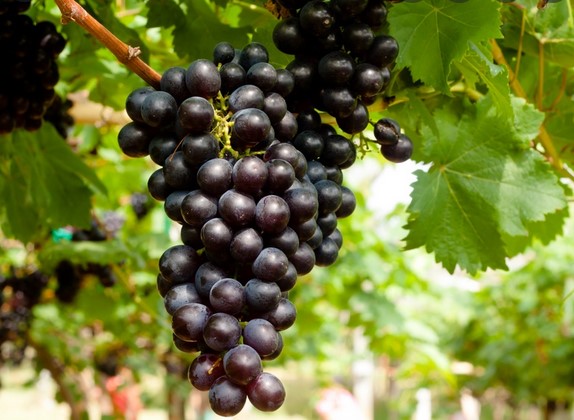American Bunch Grapes, European Bunch Grapes
Vitis labrusca (American), Vitis vinifera (European)
Characteristics
- Type: Deciduous
- Harvest: Mid-July through September
- Sun: Full Sun
- Soil: Well-Drained Sandy Loam, Loamy Sand, Loam or Clay Loam, pH 5.8 – 6.5
Culture
“Bunch grapes” refer to grape vines having berries borne within a cluster. The entire cluster, or bunch, is harvested as a uniformly ripe, intact unit. Two primary species of bunch grapes are commercially grown in the United States: the European bunch grape (Vitis vinifera) and the American bunch grape (Vitis labrusca). Two varieties of Vitis labrusca are well-adapted to all of Texas. These are Black Spanish and Champanel. Fruit on bunch grape vines may be green, red, pink, purple, black, or yellow when ripe, round or oval, thin-skinned and juicy; grapes are produced on new shoots developing from the previous year’s growth.
Noteworthy Characteristics
Grapes were first introduced to the United States by Spanish explorers in the 1700’s. Bunch grapes are the classical type of grapes used and enjoyed since the beginning of recorded history. Grapes are a berry and have typically a thin skin that yields to a fleshy interior. Bunch grapes grow in large pods that average 100 berries per bunch. Grapes are one of the world’s top 10 favorite fruits.
Problems
- The worst threat to successfully growing bunch grapes in Texas is Pierce’s disease, which shortens the life (marginal leaf burn) or kills the plants.
- Since bunch grapes are susceptible to a number of diseases and are attacked by several insect pests, a season-long spray program may be necessary to produce good fruit.
- The grape root borer (pest) is difficult to control and can destroy entire vineyards of susceptible grape varieties.
- Bunch grape varieties are typically not drought tolerant, so irrigation is highly recommended.
- European bunch grapes do not grow successfully in East and South Texas due to the climate.
- Late spring frosts can reduce yield.
- Determining the harvest of wine grapes requires either experience or a means of measuring both sugar and acid content.
Uses
Bunch grapes are commonly fresh eaten out of hand, and are also used for making juice, jam, jelly, raisins, fruit leather, and wine. The seeds can be pressed for oil and the young leaves boiled and eaten.
